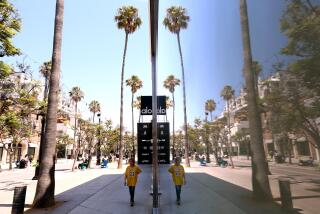Plan to Remake Roadside Strip Means Santa Better Watch Out
- Share via
CARPINTERIA — Sea-gull droppings mar his white cuffs, and the rosy glow has long since left the cheeks of the giant St. Nick that beckons travelers on U.S. 101 to Santa Claus Lane, a struggling roadside strip.
In fact, Santa’s days as a testament to 1950s kitsch may be numbered.
Property owners want to dump Santa and the lane’s year-round Christmas theme and transform the beachside attraction into a Cape Cod-style village.
Simple economics--not Scrooge--are to blame, property owners say, because Santa Claus Lane has become a mishmash of run-down and mostly vacant buildings. If the plan is approved, even the name will be changed to Beach Village Road, emphasizing the strip’s proximity to Padaro Beach.
There are no Santa fanatics rising up in outrage. Indeed, many residents of nearby Summerland, where oceanfront homes sell for as much as $7 million, applaud plans to eliminate the jolly old elf.
But Santa’s fate worries historians who point to his special place in local lore.
In 1950, a motorist down to his last dollar pulled into the Santa Claus fruit stand with five children in tow and offered to build a Santa for $500. The result was the towering concrete-and-chicken-wire statue that has stood atop the same chimney for almost five decades.
“Santa is a classic example of roadside architecture,” said David Griggs, curator of the Carpinteria Valley Museum of History. “It’s a piece of Americana. It’s mid-20th century architecture which only happened in America.”
Alexandra Cole, the historian evaluating the redevelopment project for Santa Barbara County, said she must reconcile property owners’ needs with those of travelers.
“We have a roadside icon which is larger than the local community,” Cole said. “We’re all beginning to look at ‘50s architecture. We look at the coffee shops, the diners, the roadside attractions like Santa Claus Lane, even the gas stations, and we are beginning to see [that] there was really something to them.
“I’m hoping for a compromise where people realize what Santa has always meant to Southern California culture. Perhaps he can be saved on-site in some way.”
Thirteen years ago, historians halted similar plans for removing Santa by demanding an environmental review. Different property owners decided instead to remodel storefronts on Santa Claus Lane but leave Santa intact. That effort failed, and property owners note that nearly 70% of the business properties are now vacant. Even the owner of the two oldest businesses--Toyland and Santa’s Candy Kitchen--wants to oust the relic.
“Back in the early days, it worked,” said Pete Gioia, who bought the candy store in 1969. “But the lane over the years has gotten away from the whole Christmas theme. When you think about it, Santa on the beach in Santa Barbara just isn’t a match.”
Dr. Steve Kent, a Santa Barbara cardiologist and one of the lane’s current property owners, said Santa’s cheesy image makes it difficult to find tenants.
“Here we have a property sitting right on the beach,” he said. “We have a beautiful view of the Santa Barbara coastline. That’s really the thing that could make the area special. Emphasizing the beach actually fits.
“Preserving history is important, but people are not willing to make the kind of investment for an upscale restaurant or business with Santa on their roof.”
To make their point, owners cite the nearby Padaro Beach Grill, a busy eatery that sits on Santa Claus Lane but has eschewed any association with Christmas. The place is often packed at lunch hour.
County planning officials are expected to take up the development proposal within the next year. The next stop is the California Coastal Commission. Developers must produce a report on the environmental impact of revamping Santa Claus Lane.
Santa’s roots here date back more than 50 years. Patrick and June McKeon owned the Santa Claus fruit stand on old U.S. 101 in the late 1940s. Patrick McKeon often bragged that he enjoyed the irony of creating his own “Santa” community in a state full of places with names such as Santa Monica and Santa Barbara.
The area eventually featured a carousel, a petting zoo, numerous shops, three gas stations and the only rural post office that stamped letters “Santa Claus, Calif.”
In 1954 the highway was moved inland, and Santa Claus Lane was officially born on the abandoned frontage road. The roadside attraction thrived for a while, but over the years it fell on hard times.
One main problem has been that only the most determined of visitors come. The chimney-top Santa remains visible from the freeway, but the strip is not easily reached from either the northbound or southbound exits, requiring motorists to take a circuitous route to get there.
One business after another has failed, among them the St. Nick’s coffee shop, which shut down nine months ago.
“Santa Claus Lane is just completely dead now,” said Doris McCloskey, who has lived on nearby Padaro Lane for 40 years. “I don’t think people here are overly attached to it. They think it’s tacky. It sounds elitist, but we do.”
More to Read
Sign up for The Wild
We’ll help you find the best places to hike, bike and run, as well as the perfect silent spots for meditation and yoga.
You may occasionally receive promotional content from the Los Angeles Times.






